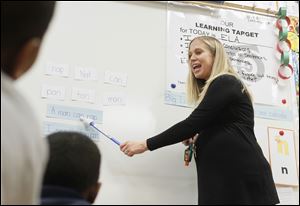
GUEST COMMENTARY
Let’s take the time to get Common Core right in Ohio
12/21/2014
CTY common16p Sarah Adams teaches reading to her kindergarten class at Martin Luther King, Jr. Academy for Boys, in Toledo, Wednesday, December 12, 2012. The lesson is part of the new Common Core curriculum being used by Toledo Public Schools. THE BLADE/DAVE ZAPOTOSKY
MANY lawmakers and political activists appear determined to perpetuate an endless debate over Ohio’s New Learning Standards, our version of the Common Core state standards. But teachers and school leaders across the state have been working hard to carry out the higher standards for student learning that we committed to years ago.
Teachers are already seeing benefits for students.
“They’re not doing as many paper-and-pencil activities and seat activities,” says Amy Whaley, a fifth-grade teacher in Toledo. “We’re up out of our seats. We’re doing projects. We’re encouraging students to talk and to share, because of the speaking and language standards that are involved.”
Like Ms. Whaley, teachers across Ohio are participating in and leading professional development, and creating new lessons designed to help students build a deep understanding of critical concepts in math and reading. Yet the challenge of introducing a new and higher set of standards, even as teachers dedicate time and energy to doing so, is significant.
Now more than ever before, our educators and schools need support to realize fully the potential benefits of Common Core for Ohio’s students.
As with any other major educational initiative, teachers, schools, and districts need time to implement the standards effectively. Expectations must shift from instant gratification to a thoughtful, multiyear transition to new curricula and classroom practices.
In Toledo, Ms. Whaley and her colleagues have worked intensively with the Toledo Federation of Teachers to build teaching frameworks and lesson plans that work best for their students.
“You have to involve the practitioners, because if you want a realistic approach to implementing these standards you’re going to have to talk to the individuals who are implementing them on a day-to-day basis,” says Kevin Dalton, the union’s president. “When you talk to those folks, you’ll get a real picture of what is needed.”
During this critical period, Ohio needs a delay in high-stakes testing. Proposed state legislation would impose a three-year moratorium on major decisions based on student test scores in measuring student growth and evaluating teacher performance. That pause would allow teachers to focus on doing what’s best for students instead of preparing for tests.
We also need to ensure that our schools have the resources they need to carry out Common Core effectively, as Toledo Public Schools is doing. School district budgets are strapped even without the additional pressure that new professional development, texts, and other Common Core-aligned resources add.
Districts need enough funding and flexibility from the state to give teachers the in-depth training and opportunities for collaboration that will lead to improved student achievement. The districts, in turn, need to use the resources they have to invest in educators during the roll-out of the new standards.
“You’re going to have to devote the time and the resources needed for high-quality professional development and to build internal capacity,” Mr. Dalton says.
Less tangible, but equally important, is the need for all Ohioans to open and maintain lines of communication among teachers, schools, districts, and parents. Change of any kind is difficult, and even more so when it affects our children.
In Toledo, the school district and teachers’ union have held a series of community forums to talk about the changes taking place as a result of the shift to new standards.
We need to move beyond the hype and panic around Common Core to discuss the successes we’re already seeing in the classroom, and the challenges that remain.
Ohio adopted these standards because so many of us agreed that they would help our students gain the mind-set and skills they need to succeed in today’s global economy. We knew the journey would be challenging.
And now, as we face the reality of these challenges together, it’s more critical than ever before for us to invest the time, resources, and collective will to do what’s right for our kids.
Melissa Cropper is president of the Ohio Federation of Teachers. Cheryl Williams is executive director of the Learning First Alliance, a Virginia-based partnership of national education groups.